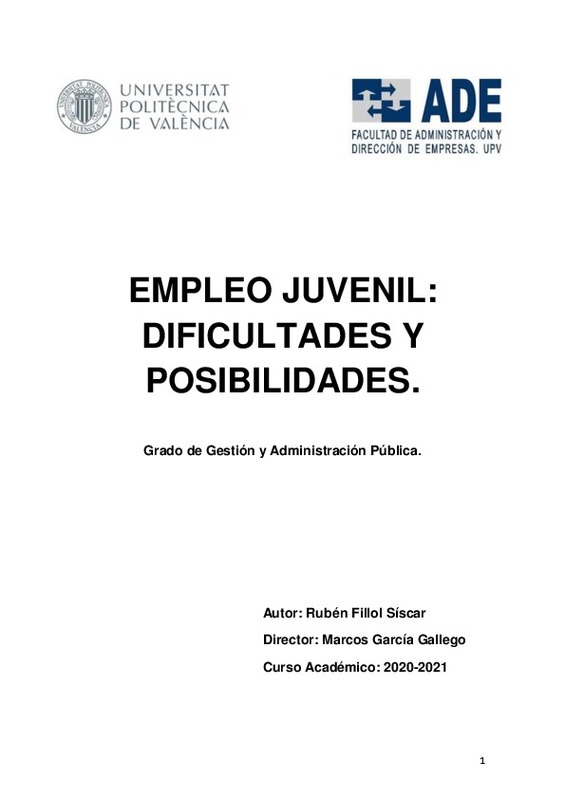JavaScript is disabled for your browser. Some features of this site may not work without it.
Buscar en RiuNet
Listar
Mi cuenta
Estadísticas
Ayuda RiuNet
Admin. UPV
Empleo juvenil: dificultades y posibilidades
Mostrar el registro sencillo del ítem
Ficheros en el ítem
| dc.contributor.advisor | García Gallego, Marcos
|
es_ES |
| dc.contributor.author | Fillol Siscar, Rubén
|
es_ES |
| dc.date.accessioned | 2021-10-20T10:17:02Z | |
| dc.date.available | 2021-10-20T10:17:02Z | |
| dc.date.created | 2021-09-30 | |
| dc.date.issued | 2021-10-20 | es_ES |
| dc.identifier.uri | http://hdl.handle.net/10251/175065 | |
| dc.description.abstract | [ES] La población joven, comprendida entre los 16-35 años, es la población que mas sufre el desempleo en nuestro país. Dentro de este rango de edad, hay que destacar que los recién titulados son quienes mas dificultades tienen para encontrar su primer empleo. Pese a los esfuerzos del gobierno en fomentar el empleo a recién titulado y a gente joven, sigue siendo un sector desprotegido en mucho aspectos. Para realizar este análisis se acudirá a los datos disponibles sobre el empleo de este colectivo de trabajadores para lo cual se realizará un estudio estadístico de dichos datos desde diferentes puntos de vista, así por ejemplo interesa estudiar si el desempleo resulta mayor en mujeres o en hombres dentro de ese rango de edades. Por otro lado, se van a abordar los diferentes aspectos que afectan a los jóvenes en la tarea de encontrar un empleo que reúna unas buenas condiciones. En primer lugar y para ubicar el trabajo normativamente, se analizará la legislación relativa a los diferentes contratos de trabajo disponibles en la ella con especial atención a los contratos dirigidos a la población joven. Del mismo modo se prestará atención a los incentivos que existen para las empresas contraten a trabajadores incluidos en ese colectivo (jóvenes de hasta 35 años). Además de lo anterior, interesa analizar las condiciones contractuales en que los jóvenes desarrollan realmente su trabajo. Así, habrá que determinar si los datos desvelan que los contratos que se ofrecen a esta población son contratos en practicas o formativos, o por el contrario son contratados mediante los contratos genéricos disponibles para el conjunto de los trabajadores. También resulta relevante determinar si se producen o no encadenamientos de contratos temporales y si, en tal caso, dichos encadenamiento se producen de forma ilegal. Finalmente, se realizará un análisis de cómo la crisis sanitaria causada por el COVID-19 ha afectado al desempleo de la población joven España y si lo ha hecho en mayor o menor medida que respecto de otros colectivos. | es_ES |
| dc.description.abstract | [EN] The young population, aged between 16-35 years, are the population that suffers most from unemployment in our country. Within this age range, it should be noted that recent graduates have the most difficulties in finding their first job. Despite the government's efforts to promote employment for recent graduates and young people, this sector continues to be unprotected in many respects. In order to carry out this analysis, I am going to address the different aspects that affect young people in the task of finding a job that meets good conditions. First of all, and in order to situate the work normatively, I will analyse the legislation that refers to hiring young people as well as the tax incentives that exist for companies that hire young people up to 35 years of age. Another point within the paper will be the contractual conditions that young people receive. In many cases, the contracts offered to this population are internship or training contracts, which means that the conditions are not adequate. There is also the case where young people are chained together, sometimes illegally, on temporary contracts instead of permanent contracts. In all these situations, the conditions for young people are worse than for other workers. A very important point is the analysis of unemployment in this part of the population, for this I will analyse different statistics, for example to study if unemployment is higher in women or in men within this age range. Finally, I will make an analysis of how the health crisis caused by COVID-19 has affected the unemployment of the young population in Spain. I will also analyse whether unemployment has increased as a result of this crisis or how the ERTE's have affected this part of the population. | es_ES |
| dc.format.extent | 79 | es_ES |
| dc.language | Español | es_ES |
| dc.publisher | Universitat Politècnica de València | es_ES |
| dc.rights | Reconocimiento - No comercial - Sin obra derivada (by-nc-nd) | es_ES |
| dc.subject | Contratos de trabajo | es_ES |
| dc.subject | Paro juvenil | es_ES |
| dc.subject | Crisis sanitaria | es_ES |
| dc.subject | COVID-19 | es_ES |
| dc.subject | Desempleo | es_ES |
| dc.subject | Trabajo | es_ES |
| dc.subject | Jóvenes | es_ES |
| dc.subject | Empleo juvenil | es_ES |
| dc.subject | Work | es_ES |
| dc.subject | Youth | es_ES |
| dc.subject | Unemployment | es_ES |
| dc.subject.classification | DERECHO DEL TRABAJO Y DE LA SEGURIDAD SOCIAL | es_ES |
| dc.subject.other | Grado en Gestión y Administración Pública-Grau en Gestió i Administració Pública | es_ES |
| dc.title | Empleo juvenil: dificultades y posibilidades | es_ES |
| dc.type | Proyecto/Trabajo fin de carrera/grado | es_ES |
| dc.rights.accessRights | Abierto | es_ES |
| dc.description.bibliographicCitation | Fillol Siscar, R. (2021). Empleo juvenil: dificultades y posibilidades. Universitat Politècnica de València. http://hdl.handle.net/10251/175065 | es_ES |
| dc.description.accrualMethod | TFGM | es_ES |
| dc.relation.pasarela | TFGM\142897 | es_ES |
Este ítem aparece en la(s) siguiente(s) colección(ones)
-
ADE - Trabajos académicos [3699]
Facultad de Administración y Dirección de Empresas






